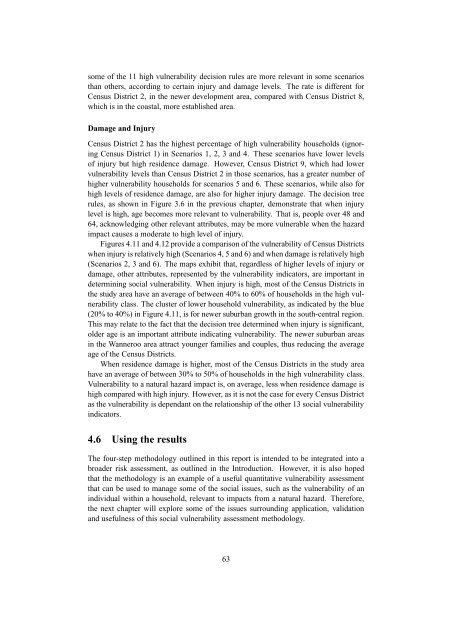Quantifying Social Vulnerability: A methodology for ... - EarthByte
Quantifying Social Vulnerability: A methodology for ... - EarthByte
Quantifying Social Vulnerability: A methodology for ... - EarthByte
You also want an ePaper? Increase the reach of your titles
YUMPU automatically turns print PDFs into web optimized ePapers that Google loves.
some of the 11 high vulnerability decision rules are more relevant in some scenariosthan others, according to certain injury and damage levels. The rate is different <strong>for</strong>Census District 2, in the newer development area, compared with Census District 8,which is in the coastal, more established area.Damage and InjuryCensus District 2 has the highest percentage of high vulnerability households (ignoringCensus District 1) in Scenarios 1, 2, 3 and 4. These scenarios have lower levelsof injury but high residence damage. However, Census District 9, which had lowervulnerability levels than Census District 2 in those scenarios, has a greater number ofhigher vulnerability households <strong>for</strong> scenarios 5 and 6. These scenarios, while also <strong>for</strong>high levels of residence damage, are also <strong>for</strong> higher injury damage. The decision treerules, as shown in Figure 3.6 in the previous chapter, demonstrate that when injurylevel is high, age becomes more relevant to vulnerability. That is, people over 48 and64, acknowledging other relevant attributes, may be more vulnerable when the hazardimpact causes a moderate to high level of injury.Figures 4.11 and 4.12 provide a comparison of the vulnerability of Census Districtswhen injury is relatively high (Scenarios 4, 5 and 6) and when damage is relatively high(Scenarios 2, 3 and 6). The maps exhibit that, regardless of higher levels of injury ordamage, other attributes, represented by the vulnerability indicators, are important indetermining social vulnerability. When injury is high, most of the Census Districts inthe study area have an average of between 40% to 60% of households in the high vulnerabilityclass. The cluster of lower household vulnerability, as indicated by the blue(20% to 40%) in Figure 4.11, is <strong>for</strong> newer suburban growth in the south-central region.This may relate to the fact that the decision tree determined when injury is significant,older age is an important attribute indicating vulnerability. The newer suburban areasin the Wanneroo area attract younger families and couples, thus reducing the averageage of the Census Districts.When residence damage is higher, most of the Census Districts in the study areahave an average of between 30% to 50% of households in the high vulnerability class.<strong>Vulnerability</strong> to a natural hazard impact is, on average, less when residence damage ishigh compared with high injury. However, as it is not the case <strong>for</strong> every Census Districtas the vulnerability is dependant on the relationship of the other 13 social vulnerabilityindicators.4.6 Using the resultsThe four-step <strong>methodology</strong> outlined in this report is intended to be integrated into abroader risk assessment, as outlined in the Introduction. However, it is also hopedthat the <strong>methodology</strong> is an example of a useful quantitative vulnerability assessmentthat can be used to manage some of the social issues, such as the vulnerability of anindividual within a household, relevant to impacts from a natural hazard. There<strong>for</strong>e,the next chapter will explore some of the issues surrounding application, validationand usefulness of this social vulnerability assessment <strong>methodology</strong>.63
















